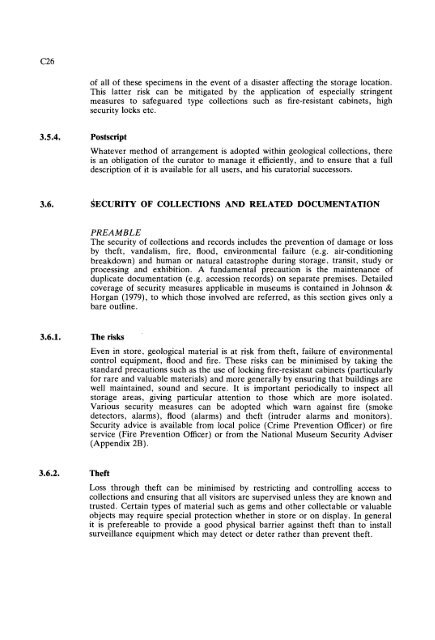GUIDELINES FOR THE CURATION OF GEOLOGICAL MATERIALS
GUIDELINES FOR THE CURATION OF GEOLOGICAL MATERIALS
GUIDELINES FOR THE CURATION OF GEOLOGICAL MATERIALS
You also want an ePaper? Increase the reach of your titles
YUMPU automatically turns print PDFs into web optimized ePapers that Google loves.
of all of these specimens in the event of a disaster affecting the storage location.<br />
This latter risk can be mitigated by the application of especially stringent<br />
measures to safeguared type collections such as fire-resistant cabinets, high<br />
security locks etc.<br />
3.5.4. Postscript<br />
Whatever method of arrangement is adopted within geological collections, there<br />
is an obligation of the curator to manage it efficiently, and to ensure that a full<br />
description of it is available for all users, and his curatorial successors.<br />
PREAMBLE<br />
The security of collections and records includes the prevention of damage or loss<br />
by theft, vandalism, fire, flood, environmental failure (e.g. air-conditioning<br />
breakdown) and human or natural catastrophe during storage, transit, study or<br />
processing and exhibition. A fundamental precaution is the maintenance of<br />
duplicate documentation (e.g. accession records) on separate premises. Detailed<br />
coverage of security measures applicable in museums is contained in Johnson &<br />
Horgan (1979), to which those involved are referred, as this section gives only a<br />
bare outline.<br />
3.6.1. The risks<br />
Even in store, geological material is at risk from theft, failure of environmental<br />
control equipment, flood and fire. These risks can be minimised by taking the<br />
standard precautions such as the use of locking fire-resistant cabinets (particularly<br />
for rare and valuable materials) and more generally by ensuring that buildings are<br />
well maintained, sound and secure. It is important periodically to inspect all<br />
storage areas, giving particular attention to those which are more isolated.<br />
Various security measures can be adopted which warn against fire (smoke<br />
detectors, alarms), flood (alarms) and theft (intruder alarms and monitors).<br />
Security advice is available from local police (Crime Prevention Officer) or fire<br />
service (Fire Prevention Officer) or from the National Museum Security Adviser<br />
(Appendix 2B).<br />
3.6.2. Theft<br />
Loss through theft can be minimised by restricting and controlling access to<br />
collections and ensuring that all visitors are supervised unless they are known and<br />
trusted. Certain types of material such as gems and other collectable or valuable<br />
objects may require special protection whether in store or on display. In general<br />
it is prefereable to provide a good physical barrier against theft than to install<br />
surveillance equipment which may detect or deter rather than prevent theft.

















